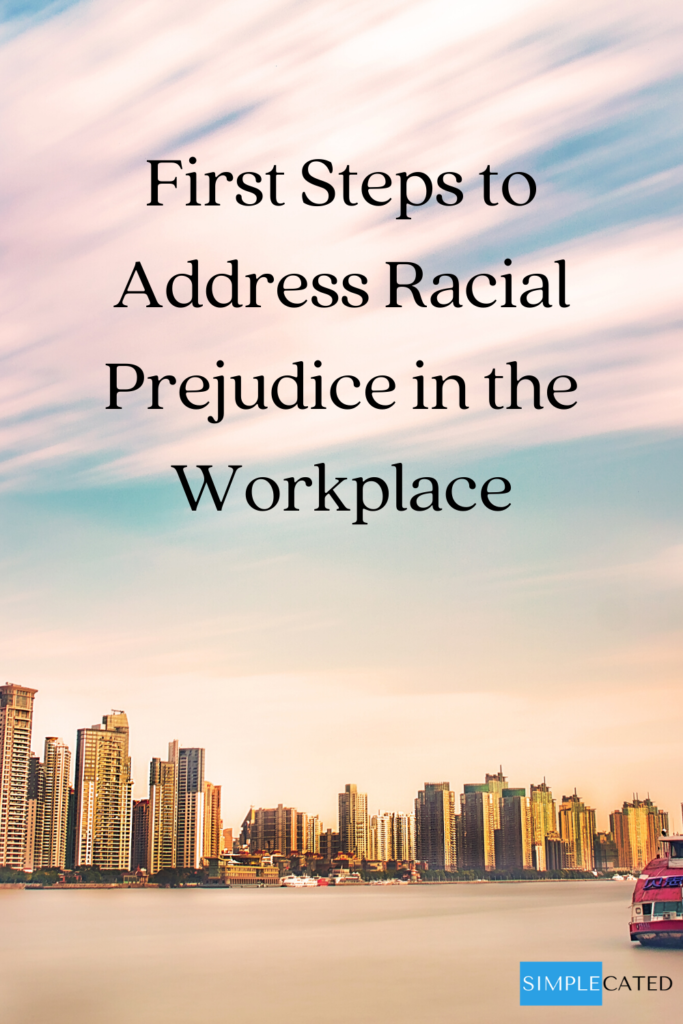In recent weeks, we’ve seen a lot of companies speak out against racial prejudice and discrimination toward the Black community and broadcast their corporate support for justice and racial equality. My guess is that, if you were to ask a random company whether they are opposed to racism and discrimination, they would (hopefully) say yes. Companies typically have some kind of anti-discrimination policy or equal opportunity employment statement. One thing we know, however, is that policy does not always equate to reality.
Your company has policies on all kinds of things, but that doesn’t mean they always happen. Think about the number of times employees have violated performance or attendance policies. You see where I’m going with this. Anti-discrimination policies are important, but having one doesn’t mean that discrimination doesn’t happen. Just having a policy isn’t enough to ensure there’s equality in the workplace.
In 2019, the Center for Talent Innovation released “Being Black in Corporate America,” a report highlighting their key findings from studying racial diversity and inclusion in the workplace. One of the key foundational issues is that White professionals don’t tend to think there’s a problem in the first place. 65% of Black professionals feel they have to work harder than others to advance in their careers, while only 16% of White employees agreed. Most Black professionals have experienced some kind of racial prejudice and microaggression at work. While a lot of companies have put various diversity and inclusion efforts into place, only 34% of full-time Black employees said they were effective. The New York Times notes that, when this study was released, only 4 of the Fortune 500 companies had a Black chief executive.
We are failing. This has to change, and it has to change now.
Where should we start? A lot of companies are developing committees and task forces to address racial prejudice in the workplace. While those could be helpful depending on how they’re conducted, we need to ensure we don’t spend all of our time creating 19-point plans that yield no action. Remember, the current diversity and inclusion efforts haven’t been very helpful, so expanding those same efforts isn’t the answer.
Policies upon policies aren’t going to help because policies don’t change the way people think. Experiences do. We need to take action to create experiences of equality in the workplace. Experiences of inclusion in every department and every staff meeting. There are some simple, foundational ways to start.
We need to take action to create experiences of equality in the workplace. Experiences of inclusion in every department and every staff meeting.
Take care of your Black employees.
There will be a time for plans and strategies, but they won’t mean anything if you don’t care. A recent Harvard Business Review article, “How Organizations Can Support the Mental Health of Black Employees,” explains that Black Americans are experiencing racial trauma with the killing of George Floyd and the numerous incidents before that as well as since then. As leaders, it’s important to take care of your employees. Ask Black employees and colleagues how they’re doing – really mean the question and then listen. Provide and encourage the use of professional resources, such as your Employee Assistance Program or on-site therapists. Let them know you are with them and want to be there for them however they need.
Own up to your problems.
Notice it’s not if there are problems. It’s also not if others have problems. Solutions need to start with looking in the mirror. Each of us can and should do better. One of the most convicting elements of the Center for Talent Innovation report for me was their finding that White women are not tending to help other groups who are underrepresented. We have received a lot of support through diversity programs but aren’t paying it forward. Change has to start with me.
As you look at your department or company as a whole, analyze where there are gaps in your providing experiences of equality and inclusion to Black employees. Involve Black employees in these dialogues, and truly listen to the answers with the intent of learning where the gaps are. (In other words, create an experience of equality and inclusion!)
Once you know the problems, keep in mind it’s your responsibility to fix them. Few things can frustrate employees more than articulating a problem in someone else only to be told to shoulder the responsibility of figuring out how to fix it. Ask your Black employees to partner with you along the way to help make sure your actions are effective, but own the responsibility to fix it as your own.
Hire Black people.
It’s impossible to truly be inclusive if you don’t have any Black employees. If you don’t have any Black employees (or have any Black candidates applying to your open positions), ask yourself why not and then make changes accordingly.
If you manage other leaders, expect them to interview and hire Black candidates. It’s that simple.
Promote Black employees.
Review the demographic data for the various levels of positions within your organization so you can see the diversity or lack thereof at each respective level. There is typically less diversity among the higher levels, so take a hard look at the data within your departments or your company as a whole to see where improvement are needed.
Make sure you’re having conversations with your Black employees about their career growth and objectives and that you’re providing support and guidance so they can be prepared for promotional opportunities. Then, when those opportunities come along, advocate for them (or promote them yourself if you’re the hiring manager).
Raise your company’s minimum wage.
In a previous article, I discussed the importance of providing a living wage for employees. This concept is incredibly important for racial equality and inclusion as well. As you review the demographic data for positions within your company, what you will likely find is fewer Black employees in the higher levels of jobs and more Black employees in the lower levels of jobs.
Take a moment to do a quick calculation of basic expenses a typical employee would encounter in your area – rent, car/gas, phone, utilities, food, etc. (Congresswoman Katie Porter has a helpful example of these calculations.) Then, calculate the minimum pay a full-time employee would need in order to make ends meet, and compare this to the pay rates at your company.
Revisit your budget, and raise your company’s minimum wage to provide your employees with a decent standard of living. Your employees should not have to choose between food or medicine, utilities or clothing, gas or their child’s birthday gift.
Align expectations accordingly.
A Black person can do any job in this company. Try saying this out loud now. A Black person can do any job in this company.
If that was hard for you, take some time to consider why. Is it because of your feelings deep down? Because of the dynamic at your company? Look straight on at your hesitancies so that you know what they are and can work through them. Again, experiences lead to change, so even if you’re working through feelings, you can commit to taking actions to have and create experiences.
As a leader, expect yourself to create ongoing experiences of equality and inclusion within your department. Attend training on unconscious bias to learn what you may need to personally guard against. Check your thought processes regarding performance management to make sure you’re being fair and consistent. Ask Black employees for feedback on how you’re doing, or conduct an anonymous survey if needed.
If you manage other leaders, have expectations that they are likewise creating experiences of equality and inclusion. In addition to reviewing hiring decisions and trends in disciplinary actions, monitor the day-to-day. Include this topic in every meeting you have with each of your leaders and ask them what actions they’ve taken recently to accomplish this.
Communicate expectations to your employees. Let them know where you stand, make it clear that racial prejudice and microaggressions are not acceptable, and include your expectations on social media posts as well. There must be zero tolerance for this type of behavior.
Accountability is key to having a workplace culture that takes discrimination and harassment seriously. Ask your Black employees to report any concerning interactions they have. If you receive a complaint, investigate it seriously. It’s easy to assume that, because you have an anti-discrimination or anti-harassment policy, the complainant is mistaken or misunderstood something and everything is fine. As we’ve already said though, just because a policy exists doesn’t mean it’s always followed. Take complaints seriously to ensure that any infractions are discovered and addressed promptly.
Don’t settle!
We must put in the work to ensure that racial prejudice and discrimination are no longer welcome in the workplace. Policies aren’t enough – we must take action to create experiences of equality and inclusion each and every day. We won’t solve everything overnight. Changing workplace culture will take time, and we need to take the time. We can start today making changes ourselves and expecting change in others. We must be willing to stay the course and insist upon equality in the workplace. To use our platforms and our influence to advocate for the rights of the Black community. It’s the right thing to do.
Photo credit: By mauropedro1969 / Canva





